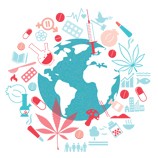UNODC World Drug Report 2016

Around five per cent of the adult population, or nearly 250 million people between the ages of 15 and 64, used at least one drug in 2014, according to the latest World Drug Report released today by the United Nations Office on Drugs and Crime (UNODC). Although substantial, this figure has not grown over the past four years in proportion to the global population. The report, however, suggests that the number of people classified as suffering from drug use disorders has increased disproportionally for the first time in six years. There are now over 29 million people within this category (compared to the previous figure of 27 million). Additionally, around 12 million people inject drugs with 14 per cent of these living with HIV. The overall impact of drug use in terms of health consequences continues to be devastating.
This report comes soon after April's UN General Assembly special session on the world drug problem (UNGASS), a landmark moment in global drug policy which resulted in a series of concrete operational recommendations. Collectively, these look to promote long-term, sustainable, development-oriented and balanced drug control policies and programmes. As UNODC Executive Director Yury Fedotov notes, it is critical that the international community come together to ensure the commitments adopted at the UNGASS are met - and the World Drug Report offers an important tool to assist with this task. "By providing a comprehensive overview of major developments in drug markets, trafficking routes and the health impact of drug use, the 2016 World Drug Report highlights support for the comprehensive, balanced and integrated rights-based approaches as reflected in the outcome document which emerged from the UNGASS."
Drug use and its health consequences
While drug-related mortality has remained stable around the world, in 2014 there were still around 207,000 deaths reported: an unacceptably high number of deaths which are preventable if adequate interventions are in place.
Heroin use, and related overdose deaths, appear to have increased sharply over the last two years in some countries in North America and Western and Central Europe. Underlining the significance of this, Mr. Fedotov noted that while the challenges posed by new psychoactive substances remain a serious concern, "heroin continues to be the drug that kills the most people and this resurgence must be addressed urgently." Overall, opioids continue to pose the highest potential harm and health consequences among major drugs.
Cannabis, meanwhile, remains the most commonly used drug at the global level, with an estimated 183 million people having used it in 2014. By analysing trends over several years, the report shows that with changing social norms towards cannabis - predominantly in the west - cannabis use has climbed in parallel with higher acceptability towards the drug. In many regions, more people have entered treatment for cannabis use disorders over the past decade.
Read more highlights and download the full report on the UNODC website